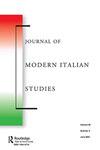The unpopular realism of Vincenzo Padula. Il Bruzio and Mariuzza Sbrìffiti
IF 0.7
3区 历史学
Q1 HISTORY
引用次数: 1
Abstract
theater of narration to a national audience and increasing the widespread dissemination of the format. Exhaustively researched over more than a decade, the book’s densely packed narrative displays some of the difficulties of transitioning a dissertation for a wider audience. The discourse had a 90s feel to it, and noticeably absent was how theater of narration fits within postdramatic and polyvocal trends that have earmarked EU theater over the past ten years. For a student seminar or theaterbased audience, selected graphs or tables would have helped differentiate eras and movements. Exploring the various dramaturgical structures would be helpful to playwrights and theater practitioners, particularly considering that the author is herself a playwright. The reader is largely left to do the unpacking while wading through the major points in the book. Although the book is undoubtedly a landmark academic study with a number of photos from important productions, accessibility factors make for a daunting read considering the unfamiliarity of most names and titles in the book, and the genre itself which Guzzetta is introducing to a new audience outside of Italy. While several erstwhile festivals are mentioned, a blind spot would be the internationally esteemed and widely reported annual festival Quartieri dell’Arte based in Viterbo and artistic directed by Gian Maria Cervo. Cervo utilizes sitespecific outlier venues like abandoned civic buildings, medieval, and historic sites for narrator-based and media experiments. This autumnal festival or the Tramedautore mentioned earlier would seem to provide a throughline to the continuing viability of the genre. It is noteworthy that festivals are the most reliable venues and funding sources for emerging Italian theater artists to disseminate their work outside of their region. Guzzetta’s opus is a major contribution to Italian theater studies particularly for English speakers and American academics whose references to Italian theater may be limited to Dario Fo’s political satires or nostalgia for Pirandello as the estimable paragon of Italian playwrights. The book’s main value is to provide a powerful, cogent, and profoundly researched historical reference and foundation that establishes not only the genre of teatro di narrazione but also encourages further inquiry and development of narrative works by theater artists and scholars.文森佐·帕杜拉不受欢迎的现实主义。Il Bruzio和Mariuzza Sbrìffiti
剧场叙事的形式越来越广泛地传播给全国观众。经过十多年的详尽研究,这本书密集的叙事展示了为更广泛的读者转换论文的一些困难。这种话语有一种90年代的感觉,而明显缺乏的是叙事戏剧如何适应过去十年来指定欧盟戏剧的后戏剧化和多焦点趋势。对于学生研讨会或剧院观众来说,选定的图表或表格将有助于区分时代和运动。探索各种戏剧结构将有助于剧作家和戏剧从业者,特别是考虑到作者本身就是一名剧作家。读者在很大程度上只能一边阅读书中的要点,一边拆开包装。尽管这本书无疑是一项具有里程碑意义的学术研究,其中有许多重要作品的照片,但考虑到书中大多数名字和标题的不熟悉程度,以及古泽塔向意大利以外的新观众介绍的类型本身,可访问性因素使阅读变得令人生畏。虽然提到了以前的几个节日,但一个盲点是国际上备受尊敬和广泛报道的年度节日Quartieri dell‘Arte,总部设在维特博,由Gian Maria Cervo执导。Cervo利用废弃的民用建筑、中世纪和历史遗址等特定场地进行叙事和媒体实验。这个秋天的节日或前面提到的Tramedautor似乎为这一流派的持续生存提供了一条主线。值得注意的是,艺术节是意大利新兴戏剧艺术家在本地区以外传播作品的最可靠场所和资金来源。古泽塔的作品对意大利戏剧研究做出了重大贡献,尤其是对英语使用者和美国学者来说,他们对意大利戏剧的提及可能仅限于达里奥·福的政治讽刺或对皮兰德洛作为意大利剧作家中值得尊敬的典范的怀念。这本书的主要价值是提供一个强有力的、有说服力的、深入研究的历史参考和基础,不仅建立了纳拉齐奥内剧院的流派,而且鼓励戏剧艺术家和学者对叙事作品的进一步探索和发展。
本文章由计算机程序翻译,如有差异,请以英文原文为准。
求助全文
约1分钟内获得全文
求助全文
来源期刊

Journal of Modern Italian Studies
Multiple-
CiteScore
1.00
自引率
25.00%
发文量
66
期刊介绍:
The Journal of Modern Italian Studies (JMIS) is the leading English language forum for debate and discussion on modern Italy. This peer-reviewed journal publishes five issues a year, each containing scholarly articles, book reviews and review essays relating to the political, economic, cultural, and social history of modern Italy from 1700 to the present. Many issues are thematically organized and the JMIS is especially committed to promoting the study of modern and contemporary Italy in international and comparative contexts. As well as specialists and researchers, the JMIS addresses teachers, educators and all those with an interest in contemporary Italy and its history.
 求助内容:
求助内容: 应助结果提醒方式:
应助结果提醒方式:


